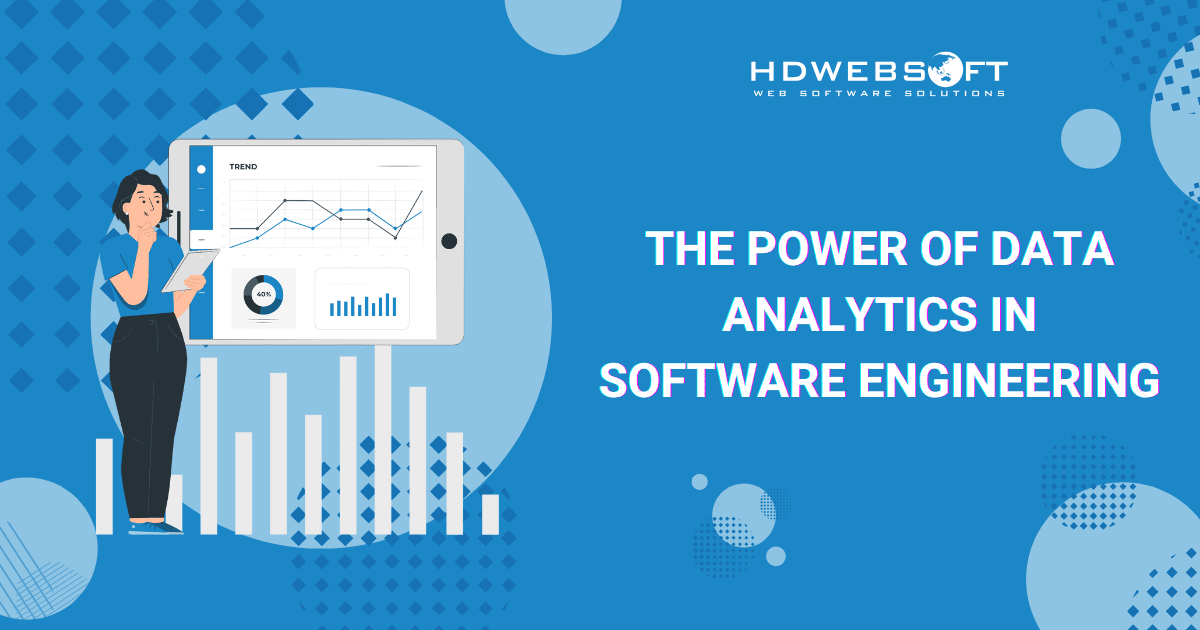
The Power of Data Analytics in Software Engineering
Data analytics in software engineering is transforming the way software is designed, developed, and optimized. By analyzing vast amounts of data, software engineers can uncover valuable insights that drive better products. From detecting bugs early to optimizing code efficiency, data analytics plays a crucial role in modern software development.
In this blog, we’ll explore what data analytics in software engineering is and how it impacts the industry. We’ll also dive into the responsibilities of data software engineers and examine the role of analytics in software development. Plus, key takeaways for effectively implementing data-driven strategies will also be mentioned. Whether you’re a developer or business leader, understanding the power of data analytics can help you build smarter and more efficient software solutions.
What is Data Analytics in Software Engineering?
Previously known as big data, data analytics in software engineering focuses on the infrastructure and tools required to manage vast amounts of information. This field goes beyond just software development. It also involves mastering programming languages, frameworks, and various data storage and processing systems. While the sheer number of available technologies can be overwhelming, many share common principles that make them easier to navigate.
Furthermore, strong SQL skills are essential for excelling in data software engineering, as they enable efficient data management and retrieval. Concurrently, Python is rapidly becoming the preferred programming language, though Java and Scala continue to be widely used.
Ultimately, this discipline brings together core software engineering practices with advanced data management, processing, and analytical techniques. As a result, it plays a vital role in handling large datasets efficiently. Moreover, it enables professionals to extract valuable insights, which can drive better decision-making and innovation in software engineering.
Why Data Analytics?
For starters, data analytics in software engineering serves as a cornerstone for continuous improvement. By meticulously analyzing user behavior and system performance, developers can identify bottlenecks, optimize code, and enhance user experience. For instance, data-driven insights can reveal patterns that inform feature development, leading to products that align more with user needs.
Moreover, data analytics facilitates proactive maintenance. By predicting potential system failures through trend analysis, teams can address issues before they escalate. Thereby, downtime and maintenance costs are reduced. This predictive capability not only ensures system reliability but also contributes to customer satisfaction and trust.
In summary, the integration of data analytics within software engineering is not merely advantageous. It’s essential. As the volume of data continues to grow, the ability to harness and interpret this information will distinguish leading organizations in the competitive landscape.
The Numbers Tell
The significance of data analytics in software engineering is underscored by its burgeoning market value. As of recent estimates, the global big data analytics market is valued at $131.4 billion in 2025, with a CAGR of 13.3%. This growth reflects the escalating reliance on data-driven strategies across industries.
What’s more, organizations are recognizing tangible benefits from their investments in data analytics. So, in 2025, 82% of organizations intend to allocate more funds toward BI and data analytics. This high success rate highlights the upcoming critical role of data analytics in achieving business objectives.
What do Data Software Engineers Do?
A data software engineering specialist focuses on designing and maintaining systems that efficiently process large-scale data. They develop applications to manage, analyze, and visualize data, ensuring businesses can make informed decisions. In particular, their role is essential in organizations that rely on data-driven insights.
Database Management and Processing
These professionals work on database design and management, a key aspect of data analytics in software engineering. Particularly, they implement solutions like data warehouses, data mesh, and data lakehouses. They also develop algorithms for data processing and handling tasks such as cleaning, normalization, and transformation.
Find out more: How HR Analytics are Revolutionizing the Industry.
You may be wondering what technologies they use to support this activity. The answer is simple: Hadoop and Apache Spark are utilized to optimize system performance and process vast amounts of data effectively. Their responsibilities often include refining database queries, enhancing code efficiency, and implementing caching strategies.
Data Integration and Governance
Beyond processing, data analytics in software development involves integrating datasets while ensuring consistency and accuracy. These specialists manage data governance, security, and visualization to make data more accessible and actionable.
Automation and Infrastructure
Additionally, they schedule automated data processing tasks using tools like Apache Airflow, shifting their focus to data quality assessments. Infrastructure decisions require expertise in cloud computing and containerization platforms like Kubernetes, which frequently support other tools. As a result, this ensures scalable and reliable data workflows.
In summary, data analytics in software engineering encompasses database architecture, data security, processing pipelines, and software development. Professionals in this field contribute to data analysis, QA, and visualization while managing ETL processes to integrate diverse datasets effectively.
Benefits of Data Analytics in Software Development
Smarter Decision-Making
First, data software engineering empowers developers with actionable insights, helping them make well-informed decisions throughout the software lifecycle. By evaluating data, they can uncover trends, detect patterns, and foresee potential issues, guiding the project in the right direction.
- Resolving development bottlenecks: Analyzing workflow data helps engineers identify productivity roadblocks and optimize processes to enhance efficiency.
- Optimizing resource distribution: Historical data can guide the effective allocation of developers, testers, and hardware. Overall, it makes sure of balanced workloads and increased productivity.
- Validating software architecture: By assessing data collected during development, engineers can confirm design choices and identify weaknesses. This allows them to refine system architecture for better scalability.
Stronger Bug Detection and Prevention
Data analytics in software engineering plays a crucial role in minimizing software defects. It evaluates system logs, bug reports, and user feedback. Then, engineers can proactively detect vulnerabilities and improve software reliability.
- Pinpointing root causes: Analyzing data allows engineers to trace errors back to their sources. Hence, it leads to faster and more effective fixes.
- Early-stage bug detection: Identifying patterns and trends in data helps engineers detect potential issues before they escalate. As a result, risks for end-users will be minimized.
- Automating error detection: Machine learning techniques can automate bug identification, reducing manual effort and improving response time.
Enhanced User Experience and Satisfaction
User behavior insights derived from data analytics in software development enable teams to refine applications based on actual user needs. This leads to higher engagement and satisfaction.
- Personalized user interactions: Analyzing behavioral data helps engineers tailor software features, improving engagement and user retention.
- User-centric design: Data analytics in software engineering insights allow for the development of intuitive, easy-to-navigate interfaces, boosting overall usability.
- Continuous improvement: Ongoing analysis of user feedback supports iterative development, ensuring applications evolve based on real-world needs.
Boosted Efficiency and Productivity
By leveraging data software engineering, teams can streamline workflows, automate tasks, and optimize system performance.
- Refining processes: Identifying inefficiencies helps automate repetitive tasks and create a more productive development cycle.
- Enhancing performance: Monitoring system data allows engineers to detect and resolve performance issues before they affect users.
- Maximizing resource usage: Data-driven insights enable smarter allocation of computing power, storage, and workforce. Ultimately, cost savings and efficiency gains are the best results.
In essence, implementing data analytics into software engineering leads to better decision-making, improved software quality, and an optimized user experience. With a data-driven approach, developers can build high-performing, scalable, and user-friendly software that meets industry demands.
The Future of Data Software Engineering
The incorporation of data analytics into software engineering is shaping the future of the industry. In today’s technology-driven world, data analytics has become essential for handling complex projects and improving development processes. As software systems grow in scale and complexity, analyzing data assists in many aspects of the process.
The role of data software engineering extends beyond just debugging or performance monitoring. It enables teams to assess code quality, evaluate system health, and predict potential failures before they happen. With the adoption of AI and ML, engineers now rely on analytics to enhance automation in testing, deployment, and maintenance.
As software engineering evolves, integrating data analytics becomes a necessity rather than an option. It empowers teams to adapt to market changes, maintain software quality, and improve long-term project sustainability. Therefore, those who embrace data analytics in software engineering will stay ahead in innovation and efficiency.
The Role of Machine Learning
One of the biggest drivers shaping the future of software engineering is machine learning. With its characteristics, machine learning in software engineering enhances automation, optimizes performance, and improves overall efficiency.
- Automated Testing: Traditional testing requires significant manual effort, but machine learning in software engineering enables automated code analysis. As you may know, AI-driven tools can detect bugs, predict potential failures, and reduce testing time, increasing software reliability.
- Intelligent Debugging: Debugging is often time-consuming, but AI models can recognize recurring error patterns and suggest fixes. This speeds up troubleshooting and minimizes downtime.
- Code Optimization: Machine learning algorithms analyze vast code repositories to identify best practices and efficiency patterns. Thus, engineers can leverage these insights to refine code structure and enhance system performance.
- Personalized Software: With user data analysis, machine learning tailors software experiences to individual preferences. From adaptive UI elements to predictive recommendations, it enhances usability and engagement.
Conclusion
Embracing data analytics in software engineering allows teams to build smarter, more efficient, and high-performing software. By analyzing data at every stage of development, engineers can make well-informed decisions that enhance both functionality and user experience.
Understanding the role of data analytics and the responsibilities of data software engineers is key to leveraging its full potential. Interpreting data-driven insights not only improves software quality but also streamlines workflows and boosts overall efficiency. As technology continues to evolve, integrating analytics into software development will be essential for staying competitive in the industry.
If you ever need help integrating data analytics into your software or developing software with that feature, look no further! HDWEBSOFT is here to help. We’re a software development company in Vietnam that specializes in performing Data and Analytics Services. It covers everything from data engineering and processing to visualization and predictive analytics. We work closely with clients to understand their unique requirements and deliver scalable, high-quality solutions. Let us help you harness the power of data to drive smarter decision-making and enhance your software’s capabilities. Get in touch with us today to discuss how we can bring your vision to life!













